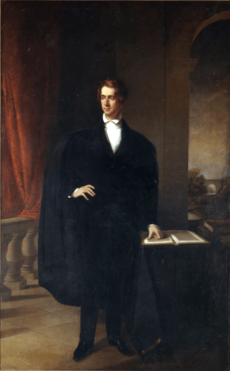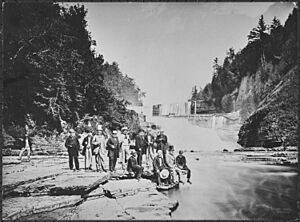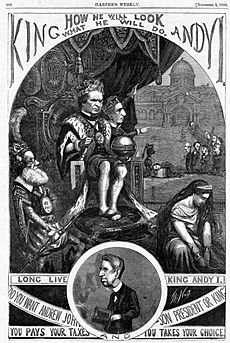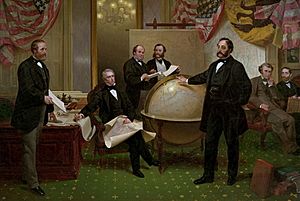William H. Seward facts for kids
Quick facts for kids
William H. Seward
|
|
|---|---|
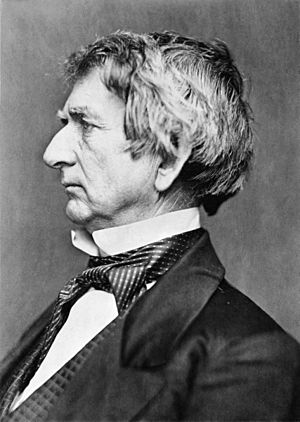 |
|
| 24th United States Secretary of State | |
| In office March 6, 1861 – March 4, 1869 |
|
| President | |
| Preceded by | Jeremiah S. Black |
| Succeeded by | Elihu B. Washburne |
| United States Senator from New York |
|
| In office March 4, 1849 – March 3, 1861 |
|
| Preceded by | John Dix |
| Succeeded by | Ira Harris |
| 12th Governor of New York | |
| In office January 1, 1839 – December 31, 1842 |
|
| Lieutenant | Luther Bradish |
| Preceded by | William L. Marcy |
| Succeeded by | William C. Bouck |
| Personal details | |
| Born |
William Henry Seward
May 16, 1801 Florida, New York, U.S. |
| Died | October 10, 1872 (aged 71) Auburn, New York, U.S. |
| Political party |
|
| Spouse | Frances Miller |
| Children | 6, including Augustus, Frederick, William, Fanny, Olive (adopted) |
| Education | Union College (BA) |
| Signature | |
William Henry Seward (May 16, 1801 – October 10, 1872) was an important American politician. He served as the United States Secretary of State from 1861 to 1869. Before that, he was the governor of New York and a U.S. Senator. Seward strongly opposed the spread of slavery before the American Civil War. He was a key leader in the early Republican Party. During the Civil War, he worked hard for the Union as Secretary of State. He is also famous for arranging the purchase of Alaska from Russia.
Contents
Early Life and Education
William Seward was born on May 16, 1801, in a small village called Florida, New York. His father was a wealthy farmer. Young William was a very bright student. He loved learning and often ran away from home to go to school!
At age 15, he went to Union College in Schenectady, New York. He was an excellent student and graduated with top honors in 1820. After college, he studied law in New York City. He passed his law exam in 1822.
Starting a Career in Law and Politics
Seward decided to practice law in Auburn, a growing town in New York. He joined the law firm of Judge Elijah Miller. On October 20, 1824, Seward married Judge Miller's daughter, Frances Miller.
Seward quickly got involved in politics. He joined the Anti-Masonic Party in 1826. This party was against secret societies like the Masons. It also opposed President Andrew Jackson and his policies.
In 1830, Seward was elected to the New York State Senate. He worked on important issues like prison reform. He also traveled a lot and met other political leaders.
Becoming Governor of New York
In 1834, Seward ran for governor of New York as a member of the Whig Party. He lost that election. However, he was elected governor in 1838 and won a second term in 1840.
As governor, Seward signed several laws that helped black residents. These laws gave them more rights and opportunities. They also guaranteed jury trials for runaway slaves in New York. He protected abolitionists (people who wanted to end slavery). He even used his power to help free black people who had been illegally enslaved in the South.
Seward also believed that all children should have access to education. He supported laws to make public education available to everyone. He also encouraged immigration to New York. He wanted new arrivals to have citizenship and religious freedom.
Serving as a U.S. Senator
After his time as governor, Seward returned to practicing law. In 1849, he was elected by the state legislature to the U.S. Senate. His strong words against slavery made him unpopular in the Southern states.
He was re-elected to the Senate in 1855. Soon after, he joined the new Republican Party. He quickly became one of its most important leaders.
The "Higher Law" and "Irrepressible Conflict"
In the Senate, Seward spoke out against slavery. In 1850, he gave a famous speech where he talked about a "higher law than the Constitution." This meant that moral laws against slavery were more important than laws that allowed it. This speech made him a leading voice against slavery.
Seward's wife, Frances, was also a strong abolitionist. Their home in Auburn became a safe place for runaway slaves on the Underground Railroad.
In 1854, a new law called the Kansas–Nebraska Act was proposed. This law would let new territories decide if they wanted slavery or not. It would also undo the Missouri Compromise, which had limited slavery in new states. Seward strongly opposed this bill.
In 1858, Seward gave another famous speech called the "irrepressible conflict" speech. He said that the U.S. had two "antagonistic systems" (slavery and freedom). He believed they would eventually clash. He said the country would have to become either entirely slave-holding or entirely free. Many Southerners saw this as a threat.
The 1860 Presidential Election
As the 1860 presidential election approached, Seward was seen as the top candidate for the Republican nomination. However, some things worked against him. His strong anti-slavery views worried some. His support for immigrants and Catholics also made some people uneasy.

At the 1860 Republican National Convention, Abraham Lincoln won the nomination instead of Seward. Seward was very disappointed. But he still campaigned for Lincoln. He traveled across the country, giving speeches to large crowds. Lincoln won the election.
Secretary of State During the Civil War
After Lincoln won, he asked Seward to be his Secretary of State. This was the most important job in the Cabinet. Seward accepted.
Trying to Prevent War
Seward tried his best to stop the Southern states from leaving the Union. He even suggested a constitutional amendment to protect slavery where it already existed. But it was too late. The Southern states began to secede.
When the Civil War began in April 1861, Seward focused on foreign affairs. He worked to make sure other countries, like Britain and France, did not get involved in the war. He did not want them to support the Confederate States.
Diplomacy During the War
Seward was very skilled at diplomacy. In 1861, a U.S. Navy ship stopped a British ship and took two Confederate diplomats. This caused a crisis with Britain. Seward helped calm the situation. He advised Lincoln to release the diplomats, which he did. This helped prevent a war with Britain.
Seward also worked to stop the British from building ships for the Confederacy. He successfully pressured them to seize two warships that were being built for the South.
Relationship with President Lincoln
Seward and Lincoln developed a close working relationship. Seward, who was more experienced in Washington, often advised Lincoln on how things worked. They would often chat and relax together. Seward came to admire Lincoln's leadership.
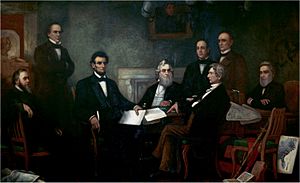
Seward was present when Lincoln read the first draft of the Emancipation Proclamation to his Cabinet. This important document declared slaves in Confederate states to be free. Seward also suggested to Lincoln that he declare a national day of thanksgiving. This led to the first official Thanksgiving Day holiday.
Assassination Attempt
On April 14, 1865, John Wilkes Booth planned to kill President Lincoln. He also assigned another conspirator, Lewis Powell, to assassinate Seward. Seward had been injured in an accident a few days before. Powell broke into Seward's home and stabbed him multiple times. Seward was seriously wounded but survived. His son Frederick and a soldier guarding him were also injured while fighting Powell.
Powell was captured and later executed for his part in the plot that killed Lincoln.
After Lincoln: Johnson's Presidency
Seward continued as Secretary of State under President Andrew Johnson. Johnson became president after Lincoln's death. Seward supported Johnson's plans for bringing the Southern states back into the Union. These plans were more forgiving than what some Radical Republicans in Congress wanted.
Congress and Johnson often disagreed on how to rebuild the South. Seward tried to help Johnson, but Johnson often didn't take his advice. This led to Johnson's impeachment by Congress. Seward helped Johnson with his defense, and Johnson was not removed from office.
Dealing with Mexico
During the Civil War, France had taken control of Mexico. They put a European prince, Maximilian, on the Mexican throne. Seward strongly believed that France should leave Mexico. After the Civil War ended, Seward told France that the U.S. wanted them out. France eventually withdrew its troops in 1867. Maximilian was captured and executed by Mexican forces.
The Alaska Purchase
Seward was very interested in expanding the United States. He believed that owning more land overseas would help American trade and naval power. He even thought about buying Greenland and Iceland!
Seward had been interested in Russian America (Alaska) for a while. In 1867, he learned that Russia might be willing to sell it. The territory was not making money for Russia. It was also far away and hard to defend. Seward quickly started negotiations with the Russian minister.
Seward offered $5 million, but they settled on $7 million. After some final talks, the price was raised to $7.2 million. The treaty to buy Alaska was signed on March 30, 1867. The Senate approved it on April 10. Many people at the time called it "Seward's Folly" because they thought it was a useless frozen land. But it turned out to be one of Seward's greatest achievements. Alaska later became very valuable for its natural resources like gold and oil.
Retirement and Final Years
After Ulysses S. Grant became president in 1869, Seward retired from public life. He returned to his home in Auburn, New York.
Seward was restless in retirement. He took a long trip across North America by the new transcontinental railroad. He visited Alaska, the land he had helped the U.S. acquire. He also traveled to Mexico.
In 1870, Seward went on a trip around the world. He visited Japan, China (where he walked on the Great Wall), India, and Europe. During this trip, he adopted a young woman named Olive Risley.
Seward began writing his memoirs when he returned home. But his health was getting weaker. On October 10, 1872, he died at his home in Auburn. His last words were, "Love one another." He was buried in Fort Hill Cemetery in Auburn.
Seward's Legacy
William Seward's reputation was debated during his life and after his death. Some people saw him as a clever politician. Others saw him as a visionary statesman.
Historians generally praise Seward for his work as Secretary of State. He skillfully managed foreign affairs during the Civil War. He prevented other countries from interfering. He also had great foresight in buying Alaska. This purchase helped prepare America for future growth.
Seward and Lincoln were two of the most important leaders of their time. While Lincoln is often more famous, Seward played a huge role in shaping the country. He worked for education for all, rights for immigrants, and the end of slavery. He also helped expand America's territory.
See also
 In Spanish: William H. Seward para niños
In Spanish: William H. Seward para niños
- Sites and works regarding William H. Seward


